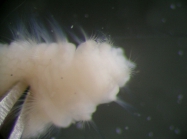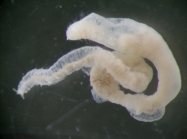| Introduction | | Species lists | | Search taxa | | Taxon tree | | Literature | | Distributions | | Statistics | | Editors | | Match taxa | | Webservice | | Log in |
CaRMS taxon detailsAsclerocheilus Ashworth, 1901
129551 (urn:lsid:marinespecies.org:taxname:129551)
accepted
Genus
marine,
recent only
masculine
Ashworth, James Hartley. 1901. The anatomy of <i>Scalibregma inflatum</i> Rathke. Quarterly Journal of Microscopical Science, London, 45: 237-309., available online at https://www.biodiversitylibrary.org/page/14709616
page(s): 297 [details]
Etymology It is not clear from his text why Ashworth (1901) used Asclerocheilus. Grube's Sclerocheilus is a composition of the words...
Etymology It is not clear from his text why Ashworth (1901) used Asclerocheilus. Grube's Sclerocheilus is a composition of the words Sclero, 'hard', and Cheilus, 'lips' or 'rim'. Greek 'cheilos' is neuter, as would be 'cheilus' but Grube made a masculine noun compound word as Sclerocheilus. Addition of the Greek 'A' by Ashworth is a negative, thus meaning not with hard lips/rim, but his short diagnosis has nothing that fits that character state. [details]
Read, G.; Fauchald, K. (Ed.) (2025). World Polychaeta Database. Asclerocheilus Ashworth, 1901. Accessed through: Nozères, C., Kennedy, M.K. (Eds.) (2025) Canadian Register of Marine Species at: https://www.marinespecies.org/carms/aphia.php?p=taxdetails&id=129551 on 2025-05-04
Nozères, C., Kennedy, M.K. (Eds.) (2025). Canadian Register of Marine Species. Asclerocheilus Ashworth, 1901. Accessed at: https://www.marinespecies.org/CaRMS/aphia.php?p=taxdetails&id=129551 on 2025-05-04
Date action by
original description
Ashworth, James Hartley. 1901. The anatomy of <i>Scalibregma inflatum</i> Rathke. Quarterly Journal of Microscopical Science, London, 45: 237-309., available online at https://www.biodiversitylibrary.org/page/14709616
page(s): 297 [details] taxonomy source Blake, James A. (2025). New species and records of Scalibregmatidae (Annelida) from the Atlantic Ocean, Indian Ocean, Pacific Ocean, Southern Ocean, and adjacent seas. <em>Megataxa.</em> 16(1): 1–232., available online at https://mapress.com/mt/article/view/megataxa.16.1.1 [details] additional source Fauchald, K. (1977). The polychaete worms, definitions and keys to the orders, families and genera. <em>Natural History Museum of Los Angeles County: Los Angeles, CA (USA), Science Series.</em> 28:1-188., available online at http://www.vliz.be/imisdocs/publications/123110.pdf [details] additional source Bellan, G. (2001). Polychaeta, <i>in</i>: Costello, M.J. <i>et al.</i> (Ed.) (2001). European register of marine species: a check-list of the marine species in Europe and a bibliography of guides to their identification. <em>Collection Patrimoines Naturels.</em> 50: 214-231. (look up in IMIS) [details] identification resource Blake, James A. (2023). New species of Scalibregmatidae (Annelida) from slope and abyssal depths off eastern Australia. <em>Records of the Australian Museum.</em> 75(3): 271-298., available online at https://journals.australian.museum/blake-2023-rec-aust-mus-753-271298/ page(s): table 1; note: synoptic table comparing morphological characters of 15 known species of Asclerocheilus [details] Available for editors identification resource Mendes, Samuel Lucas Da Silva Delgado; De Paiva, Paulo Cesar; Rizzo, Alexandra E. (2024). On species of Asclerocheilus Ashworth, 1901 (Annelida: Scalibregmatidae) from Brazil. <em>European Journal of Taxonomy.</em> 947: 88-108., available online at https://europeanjournaloftaxonomy.eu/index.php/ejt/article/view/2621 page(s): 103; note: world key to genus [details] Available for editors  Present Present  Inaccurate Inaccurate  Introduced: alien Introduced: alien  Containing type locality Containing type locality
From editor or global species database
Diagnosis [Diagnosis of Blake, 2025] Body elongate, arenicoliform. Prostomium with a pair or lateral or frontal horns. Parapodia of posterior segments reduced; dorsal and ventral cirri absent; interramal papillae or lobe present or absent; postchaetal lamellae absent. Branchiae absent. chaetae include capillaries, furcate chaetae, and large, conspicuous curved spines on setigers 1, 1–2, 1–3, or 1–4, sometimes accompanied by short spinous chaetae anterior to spines. Pygidium with long anal cirri. [details]Etymology It is not clear from his text why Ashworth (1901) used Asclerocheilus. Grube's Sclerocheilus is a composition of the words Sclero, 'hard', and Cheilus, 'lips' or 'rim'. Greek 'cheilos' is neuter, as would be 'cheilus' but Grube made a masculine noun compound word as Sclerocheilus. Addition of the Greek 'A' by Ashworth is a negative, thus meaning not with hard lips/rim, but his short diagnosis has nothing that fits that character state. [details] Grammatical gender Masculine. Although 'sclerocheilus' should be neuter, Grube's Sclerocheilus usages are as masculine and thus so are Asclerocheilus usages. All adjectival species names have used masculine suffices. It would be disruptive now to insist adjectival names paired with Asclerocheilus had neuter endings rather than masculine. [details] |


